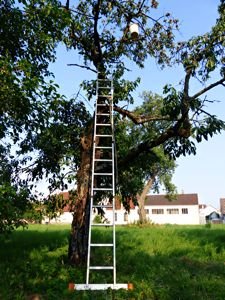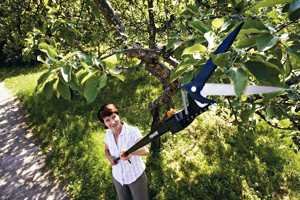For a whole range of fruit trees in garden, winter is the right time for pruning to stimulate growth in the forthcoming budding phase. This applies, for example, to apple and pear trees. In addition, the trees do not have any leaves during the dormant period, which means that the density and structure of the tree crown can be assessed particularly well. However, when it comes to medium-sized or tall trees, the pruning often has to be carried out from a ladder, and this naturally entails risks. How best to prepare for these risks and avoid accidents is something the accident experts from the Therefore insurance some valuable tips.
Gardening is also a sometimes demanding manual activity that should not be taken lightly. According to the Federal Institute for Occupational Safety and Health, 200,000 garden accidents occur every year. Of the accidents that happen while pruning, falls from ladders are the most common. This also makes it clear where to start when it comes to accident prevention.

This begins with the selection of the ladder. Aluminum ladders are best. Not only are they easier to transport due to their low weight, but above all, unlike wooden ladders, they cannot become rotten. A suitable ladder must also be able to stand securely. Depending on the surface, this can be achieved with non-slip plastic coatings on the lower ends of the handlebars, with steel spikes that can be stuck into soft ground or with a device that can adapt to uneven ground.
Furthermore, the ladder must be long enough. There are numerous models today that can be stowed away compactly using telescopic mechanisms or by assembling several parts and yet can be extended to great heights. The ladder should not just reach the desired working position, it should also be so long that you don’t have to climb further than the fourth highest rung in order to be able to work comfortably. Needless to say, but important nonetheless: get a high-quality brand guide and refrain from bargain offers whose quality you cannot assess the quality of.
Use ladder safely

If the ladder is leaned against the tree, this must be done on a strong branch that does not bend or move noticeably due to the weight leaning against it. To avoid being endangered by a sudden yielding of the ground or the ladder shifting due to movements in the heat of the moment, you should also fix it to the branch with a rope or belt.
If you climb up to the fourth last step at most, you can also find support on the bars and rungs in front of your body if necessary. You shouldn’t move too far away from them while you’re working: Turning backwards on the ladder is usually a bad idea, but it’s much more common for hobby gardeners and do-it-yourselfers to lean far to the side in order to make the best possible use of their radius of action. This saves time, but dramatically increases the risk of a fall. Rather move the ladder a little and then continue the work from a safe, stable position.
Also important, by the way: wear sturdy, non-slip shoes! The best ladder and safest setup is useless if you slip off the rungs. Stability also means not throwing the clippings onto the ladder. If it stays on a rung, there is a risk of slipping off, even with safe shoes.
Alternatives to the ladder
Movable work platforms are also suitable as a safe base for cutting particularly high hedges. When pruning trees, this option is not available regularly. But there are other alternatives here. Telescopic pruning shears, for example, are popular and available quite cheaply. They allow twigs and branches of manageable diameter to be trimmed while standing firmly and securely on the ground. Telescopic scissors reach several meters high and often save you having to climb a ladder.


In many cases, thicker branches can be reached with a so-called pole pruner. This is a small chainsaw, which is equipped with a petrol or battery drive and also sits on a long operating rod. You can easily see through branches with it. This can also be done with a hand-operated telescopic saw – it is cheaper but requires more effort.
Whether telescopic scissors, pruning saw, or pruner: Always look for a position when working with it that maintains a sufficient lateral distance from the cut. Otherwise, the clippings can fall on your head – their weight and the force with which it falls is easy to underestimate. If in doubt, you should wear a forestry worker’s helmet, which professionals also use to protect themselves during such work.








